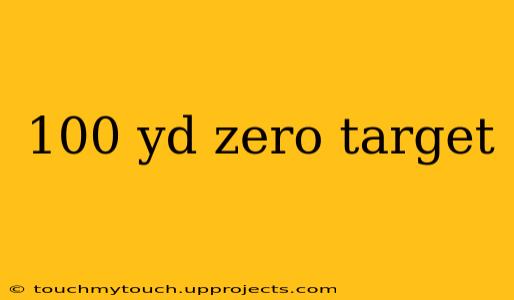The 100-yard zero is a crucial benchmark for long-range shooting, providing a solid foundation for further adjustments and improved accuracy. Achieving a consistent 100-yard zero requires a deep understanding of your rifle, ammunition, and the environmental factors influencing your shot. This comprehensive guide explores the techniques and considerations necessary to master the 100-yard zero target.
Understanding the Importance of a 100-Yard Zero
Before diving into the process, it's vital to understand why the 100-yard zero is so significant. This zeroing distance represents a sweet spot where many rifles, particularly those chambered in popular hunting and target shooting calibers, exhibit minimal bullet drop. A properly established 100-yard zero provides:
- Simplified Range Estimation: With a known zero, calculating bullet drop at other ranges becomes significantly easier, streamlining your shooting process.
- Improved Accuracy at Common Hunting and Target Distances: The 100-yard range falls within typical engagement distances for many shooting disciplines.
- Foundation for Longer-Range Shooting: Achieving a precise 100-yard zero is essential for progressing to longer distances and more challenging shots.
Equipment and Preparation: Setting the Stage for Success
Achieving a consistent 100-yard zero requires meticulous preparation. This involves selecting the right equipment and ensuring optimal environmental conditions:
- High-Quality Rifle and Optics: A well-maintained rifle and a clear, properly sighted scope are paramount. Ensure your scope is properly mounted and shows no signs of damage or misalignment.
- Ammunition Consistency: Use only one type of ammunition for zeroing, ensuring batch consistency for predictable performance. Variations in ammunition can significantly impact bullet trajectory.
- Stable Shooting Rest: A solid, stable shooting rest is crucial to minimize movement and enhance accuracy. A shooting bench or sandbag rest are ideal choices.
- Weather Considerations: Wind, temperature, and humidity can all affect bullet trajectory. Ideally, zero your rifle on a calm, clear day with stable temperature conditions. Record these conditions for reference.
- Appropriate Safety Gear: Always prioritize safety. Wear hearing and eye protection at all times during the zeroing process.
The Step-by-Step Zeroing Process: From Initial Sight-In to Fine-Tuning
Zeroing a rifle at 100 yards involves a systematic approach, typically involving multiple adjustments and verification steps:
1. Initial Sight-In: Getting on Target
Begin by making rough adjustments to your scope's elevation and windage turrets to bring your shots onto the target. It's common to start with a relatively large adjustment to get in the ballpark and then refine the adjustments gradually.
2. Group Shooting and Adjustment: Identifying the Point of Impact
Once your shots are reasonably close to the center of the target, fire a three-shot group. Analyze the group's point of impact (POI) relative to the point of aim (POA). This will determine the necessary adjustments.
3. Incremental Adjustments: Refining the Zero
Adjust your scope turrets using the appropriate correction for your particular optic, making incremental adjustments based on your POI. Most scopes are marked with adjustments measured in minutes of angle (MOA) or milliradians (mils), allowing for precise fine-tuning.
4. Verification and Refinement: Reaffirming Accuracy
After making adjustments, fire another three-shot group to verify your corrections. Repeat this process until your shots are consistently grouped tightly around your desired point of aim at 100 yards.
Beyond the Zero: Considerations for Optimal Performance
While a 100-yard zero is a critical starting point, achieving consistent accuracy across a wider range of distances necessitates further understanding:
- Bullet Drop Compensation: Understanding how bullet drop affects trajectory at various ranges is crucial for accurate long-range shooting. Using a ballistic calculator can help determine the necessary adjustments.
- Wind Compensation: Wind can significantly impact bullet trajectory. Learning to read and account for wind is essential for making accurate shots, particularly at longer distances.
- Environmental Factors: Temperature, humidity, and altitude can all affect bullet velocity and trajectory. Understanding these influences and how they impact your shots allows you to adjust accordingly.
Conclusion: The Ongoing Pursuit of Precision
Mastering the 100-yard zero is a journey of continuous learning and refinement. Through consistent practice, careful attention to detail, and a solid understanding of the factors impacting projectile trajectory, shooters can achieve the precision and accuracy necessary for success in various shooting disciplines. Remember, safety is always paramount. Practice responsibly and enjoy the rewarding challenge of refining your shooting skills.
